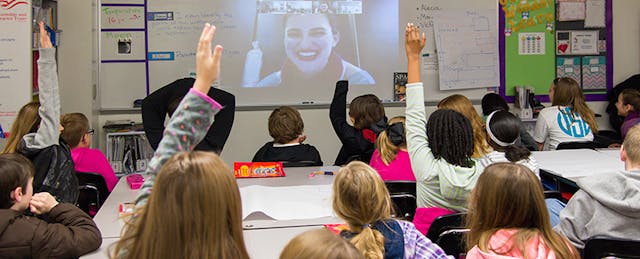More than 350 million people use LinkedIn to network, share stories and, in most cases, find new career opportunities. But the “professional” social media network is also connecting people who have no résumé, skills or are too young to even create their own profiles.
“The vision of LinkedIn is to create economic opportunity for every member of the global workforce,” says Meg Garlinghouse, Head of LinkedIn for Good. “Education is obviously a critical component of the pathway to economic opportunity.”
The company has partnered with Nepris, a Dallas, TX-based startup that offers a video platform where industry leaders can volunteer to connect with classrooms and share their experiences and career paths. Founded in 2013, Nepris helps students understand how what they learn in textbooks or with software actually applies to real-world job opportunities. And in doing so, Nepris hopes to help bridge the gap between education and the industry workforce.
Since November 2014, Nepris has used LinkedIn’s API to communicate session requests to the over six million LinkedIn members who have expressed an interesting in sharing their expertise with students.. Here’s how it works: A teacher submits a session request to Nepris that includes details about what subject or lesson he wants to cover. The company posts these requests as volunteer opportunities on LinkedIn where interested professionals can signal their willingness to participate. If the Nepris team deems the volunteer to be a good fit, she then signs up on the Nepris website and arranges a time for her online session.
It’s been quite a fruitful relationship, says Nepris’ co-founder and CEO Sabari Raja. “As a K-12 startup, we don’t have access to millions of professionals. So we are putting this relationship to good use and building this pipeline of skills-based volunteering in Nepris.” Today, 60 percent of Nepris connections come via LinkedIn. On the flip side, over half of Nepri’s network of 4,500-plus industry professionals have signed up through the social media network.
Not having to worry about matchmaking and vetting responsibilities is a joy for teachers like Ashere Potter, who teaches math and science at Aldrige Elementary in Plano, TX. During the 50 Nepris-enabled sessions she has conducted in her classroom over two years, she has featured volunteer experts in cats, beetles, fashion design and prosthetic limbs. “It’s really about the real-world connection,” Potter tells EdSurge. “Students see how the stuff they’re learning in class can benefit them when they go out in the real world.”
Currently, the most popular sessions on Nepris feature professionals from engineering and science backgrounds. One of Potter’s expert guests was Michelle Grewal, a technology manager at Ava Anderson, who spoke about her diverse engineering career at high-tech companies. “I was looking for a way to connect with students to inspire them the way other people helped and inspired me,” says Grewal. It was personally satisfying for her to share insights into her work, especially “for kids for whom math and science seem scary.”
Not all sessions are a guaranteed hit. Potter recalls a few “duds,” where speakers simply gave Powerpoint presentations or were otherwise uninspiring. She adds, Nepris “takes feedback seriously and will share it back to the presenters.”
There is no money exchanged between LinkedIn and Nepris as part of the partnership. Teachers can sign up for a free account with basic features or pay $149 per year for a premium account with unlimited sessions. The company has also solicited sponsors, including Samsung and Randstad, to cover this cost for schools as part of their philanthropic efforts.
For LinkedIn, this partnership is just the latest in a series of socially impactful partnerships that are part of the “LinkedIn for Good” program, which started in 2010. The company is currently also working with MentorNet and Year Up to open career opportunities to young people of diverse backgrounds.
Volunteering one’s time, of course, can also be a valuable form of karmic currency; surveys conducted by LinkedIn show that 41 percent of hiring managers in the US equate volunteering to full-time work, and 20 percent say they’ve hired someone because of volunteering experience.
Being able to interact with scientists—rather than just read about them—can go a long way toward getting students engaged in their studies, Potter notes. A couple of older students in her district even got internships with local businesses through the Nepris connection.
“Nepris does a terrific job helping inspire young people to start thinking about their dream jobs,” observes Garlinghouse. “They help make classroom work relevant to the real world which in turn keeps more students in school.”


